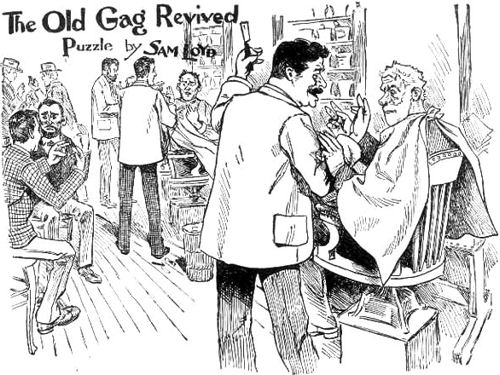



ONE OF OUR GREAT office buildings was thrown into a state of utter demoralization the other day by a stupid mathematical chestnut which has been going the rounds for nearly a century. It was the old gag of the apple woman who sold thirty apples at the rate of three for a cent, while another sold thirty apples at the rate of two for a cent, so the first received ten cents and the other got 15 cents, making 25 cents in all. The next day they formed a little apple trust, and combined to sell five for 2 cents, but at the close of business found that the sales only netted 24 cents, so each one accused the other of having purloined the missing, penny.
In the present instance eggs are substituted for apples, which some people consider a sufficient change to entitle them to the credit of having originated a new puzzle. Dutch Frank, generally known as the “calculating barber,” sprung it upon a life insurance agent, who, considering himself away up in figures, would not yield the point without dragging every one who was in the shop into the discussion, so, before long the business was at a standstill and the argument spread through the entire building as well as adjoining neighborhood. Frank claims that there are two sides to the question, and that barbers, lawyers, doctors and clergymen take one view of the subject, while business men and those who sell things take the other. He even says that from their answers to the puzzle he can tell a professional man from a merchant. Let us look at the puzzle so as to see what it really amounts to.
During an Easter banquet, when ten dozen eggs were consumed without intermission, thirty eggs were eaten during the first course at a rate of three eggs per minute, which would take just ten minutes. During the second course thirty were eaten at the rate of two per minute, which would be fifteen minutes more. Then, finally, in the third course, the remaining sixty eggs were eaten, first three and then two in a minute, alternately, so as to again average five eggs in two minutes.
“Not to bother your head with the mathematics of the situation,” says Dutch Frank, “I will just ask you to tell me how long would it have taken to eat those ten dozen eggs if there had been but half as many guests at the banquet? ”
Many clever puzzlists and mathematicians got caught on at least one of the two catches presented in this new version of the old-line apple women’s problem. In saying that thirty eggs were eaten during the first course of an Easter banquet, at the rate of three eggs per minute, would naturally require ten minutes, and to eat thirty more at the rate of two eggs per minute would be fifteen more, so that sixty' eggs were eaten in twenty-five minutes. But during the third course, when sixty more eggs were consumed, first three in a minute and then two in a minute alternately, so as to again average five eggs in two minutes, those who know the mathematics of the situation can see that five eggs in every two minutes would consume the sixty eggs in twenty-four minutes, so the entire dozen eggs would he eaten in exactly forty-nine minutes!
But the Dutch barber wanted to know “how long it would have taken to eat those ten dozen eggs if there had been but half as many guests at the banquet? ” The mathematicians fell into the mistake of saying that if the eggs were eaten in forty-nine minutes, half the number of guests would have required twice the time, viz: ninety-eight minutes. It took the clever puzzlists, however, to discover that the eggs, which must have been very small ones, were all eaten by one person! It was a very exclusive banquet with but one guest! So half the number of guest could not have eaten the eggs at all! Take the time as stated: Thirty eggs in ten minutes, then thirty in fifteen and sixty in twenty four, and you can plainly see that but one egg was being eaten at a time, and as it was said they were eaten without intermission, it would require but one person to do the job!
More than one person could not conform to the terms of the problem. The last sixty eggs were eaten first three in a minute and then two in a minute. How could two persons eat three eggs? Or how could three persons eat two? There is no number which will divide into two and three, except one!
2.
What is the difference between a woman and an umbrella? You can shut an umbrella up.
Why would it be very appropriate for a man named Benjamin to marry a girl named Annie? Because he would be Bennie fitted and she Annie-mated.
When is a horse like a house? When he has blinds on.
Why is modesty the strongest characteristic of a watch? Because it always keeps its hands before its face, and runs down its own works.
Why is it dangerous to keep a clock at the head of a pair of stair? Because it sometimes runs down and strikes one.
Why are mortgages like burglars? Because they secure your money.
When were there only two vowels? In the days of No-a, before U and I were born?
What, as milliners’ say, is “the sweetest thing in bonnets?” A lady's two lips.
What question is that to which you must always answer “yes?” What does y-e-s spell?
[Page 153]